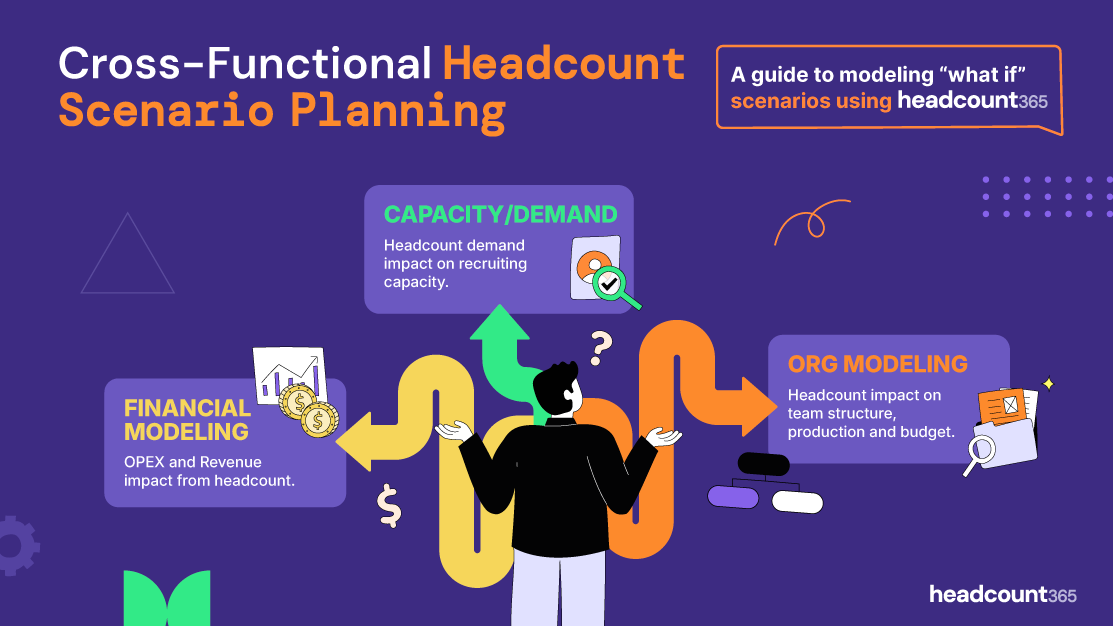A Guide to Headcount Scenario Planning
Table of Contents
Headcount Scenario Planning: A Practical Guide to Getting It Right
Headcount scenario planning isn't about guessing. It’s about building a flexible model that accounts for the reality that business plans change — and making sure you can actually execute when they do.
Three key objectives to what-if modeling:
1. Org Modeling: Mapping Teams Against Demand
Hiring teams need to map production capability against production demand. You aren't just rearranging people—you’re building a structure where producers, managers, and operational support can meet business goals without overspending.
2. Financial Modeling: Cost of Outcomes
People cost money to produce outcomes. Headcount scenario planning surfaces the financial trade-offs between departments early, so you're not stuck negotiating after the fact.
3. Recruiting Capacity Modeling: Can you hire?
Changing a hiring plan without modeling recruiting capacity is how timelines get blown up. You need to know if your recruiting team can realistically deliver on the start dates you're targeting.
Key Inputs, Compromises, and Restrictions in Headcount What-If Scenarios
When you're building headcount what-if scenarios, you’re not operating in a vacuum. Real-world limits apply, and you have to model around them.
Org Modeling
Stakeholders Involved:
Hiring Managers: Which team structure is best to meet goals?
Budget Owners: Does this scenario fit the financials I’ve forecasted for this department
HR Business Partners (HRBPs): Are changes maintaining workplace equity?
Goals:
Build a team structure that can hit production goals—inside the limits of your budget.
Get Approval from other stakeholders to make these changes
Common Org Modeling Examples:
Sales Planning: How many sellers do I need? How do ramp time, attrition, and hiring timelines factor in?
Budget Adjustments: How do I restructure a team when my budget changes?
Internal Mobility Impact: How does promoting or losing team members change my external hiring plan?
Key Restrictions to Consider:
Management Ratios: IC:Manager, Manager:Sr. Leader, Ops Staff:Headcount
Compensation Framework: Pay equity and title/role alignment
Fully Burdened Headcount Cost: Varies by location, level, and department
Support Staff Thresholds: When to consolidate ops or admin roles
Job Leveling Framework: Clear responsibility-to-title alignment
Succession Planning: Building career paths to keep your team engaged
Attrition Modeling: Accounting for expected turnover in net hiring needs
Organizational modeling helps leaders ensure every employee is set up to succeed in an equitable environment. It’s easy to add ICs to help meet demand (sellers hitting quota, or recruiters hiring people) but the proper management & support staff, or an equitable lens over levels & compensation you open the business up to long-term risk
Financial Modeling
Stakeholders Involved:
Budget Owners: How do changes to headcount impact my budget
FP&A Partners: How can we change headcount to fit a new budget goal
VP of FP&A: What will the total cost of headcount be relative to these new goals, and what savings/overage does it create relative to my initial budget committed to our execs and board
Goals:
Model the OPEX or revenue impacts of adding or removing headcount.
Examples:
Sales Expansion: Adding headcount to support new revenue
Budget Constriction: Reducing heads to meet new OPEX targets
Horse Trading: Evaluating financial impact of team restructures proposed by budget owners
Attrition and Backfilling: Strategic planning to minimize revenue disruption (headcount365’s predictive backfilling helps finance leaders keep maintain revenue from attrition)
Globalization: Offshoring impacts salaries— but how does it impact production? What’s the trade off?
Key Restrictions:
Management Ratios: You might be able to hire twice the people in a different countries for the same price, but what else is needed to ensure this increase is sustainable?
Compensation Framework: How does your comp framework hold up in different locations? One of the largest things I had to deal with during my time at Uber was how to distribute equity.
Fully Burdened Headcount Cost: Salary is just one piece of the pie. What are the other costs of employing someone, and how does that impact decisions on location, title, or spend?
Financial headcount modeling helps leaders see trade-offs so enticing variances in salary or start dates don’t create hidden or unexpected financial impact.
Recruiting Capacity Modeling
Stakeholders Involved:
Recruiting Leaders: Do I have enough recruiting capacity to meet this demand? Do I have budget to supplement my team with external hiring or additional staff
Budget Owners: What start dates are feasible for my new hires?
FP&A: What’s the total cost of hiring in addition to the budgeted salaries of the new hires
Goals:
Model whether your recruiting team can handle the new or shifted demand on time.
Common Recruiting Capacity Scenarios:
New Hiring Plans: Fresh roles = fresh workload for recruiting
Start Date Acceleration: Earlier start dates may be unachievable with current recruiting resources
Plan Variance: Any plan change must go through recruiting capacity modeling
Without integrating recruiting capacity into your headcount scenario planning, hiring delays are almost guaranteed.
Why Headcount What-If Scenario Planning Is Critical
Headcount changes are inevitable. Headcount scenario planning helps the business ensure they have the right employees for the right budget.
With Headcount365, teams can build, flex, and track headcount modeling in real-time. Recruiting Leaders have a future looking capacity/demand forecast to help finance, budget owners and the business as a whole understand their capability to meet the demand. Every Scenario Plan goes through a customizable approval processes that helps every stakeholder stay on top of the changes. No more redoing spreadsheets every time leadership changes their mind. Every what-if gets modeled, documented, and tied back to the plan.
If you want to make better headcount decisions faster—and make sure you can actually hire the teams you plan for—you need a living headcount model, not just a static plan.

